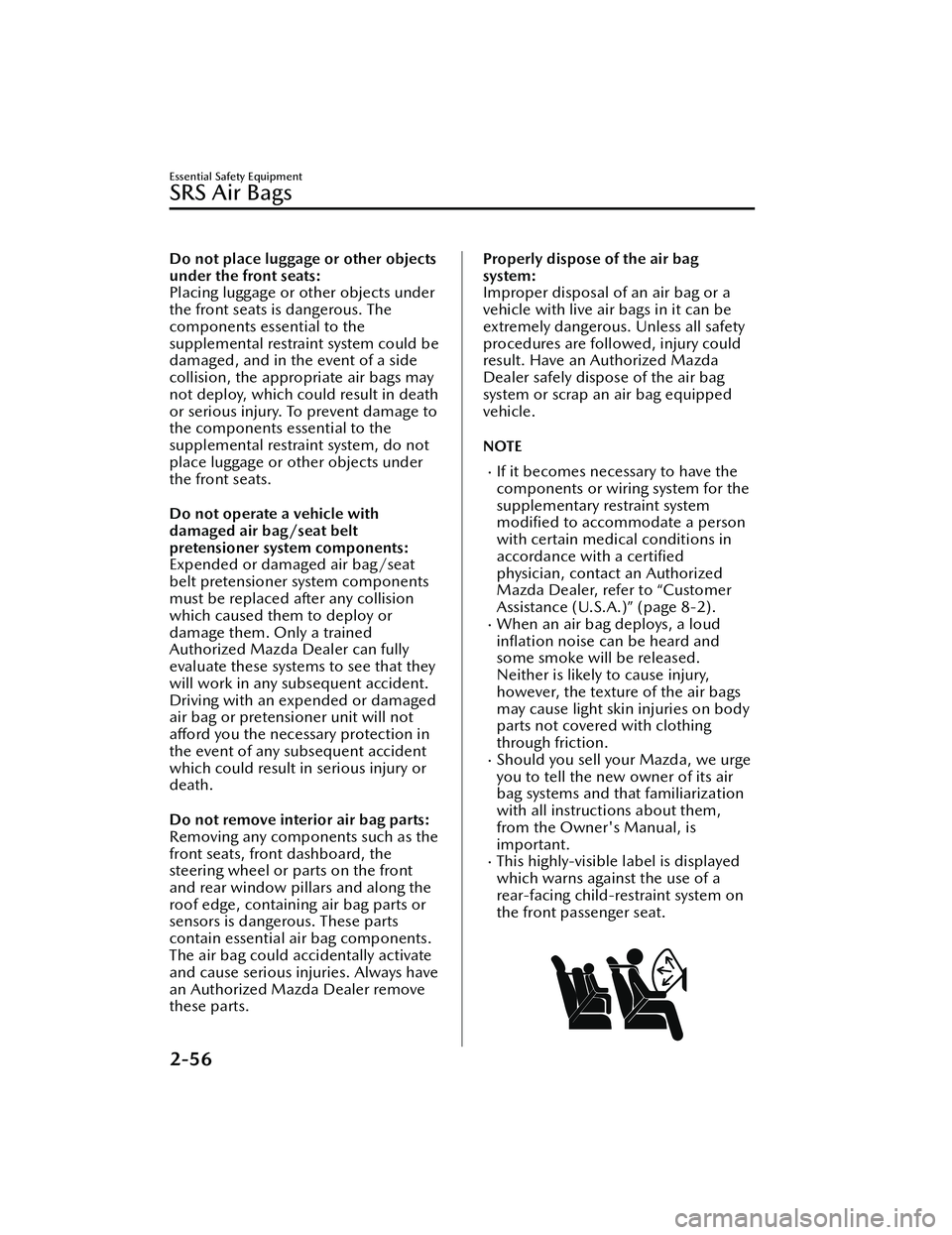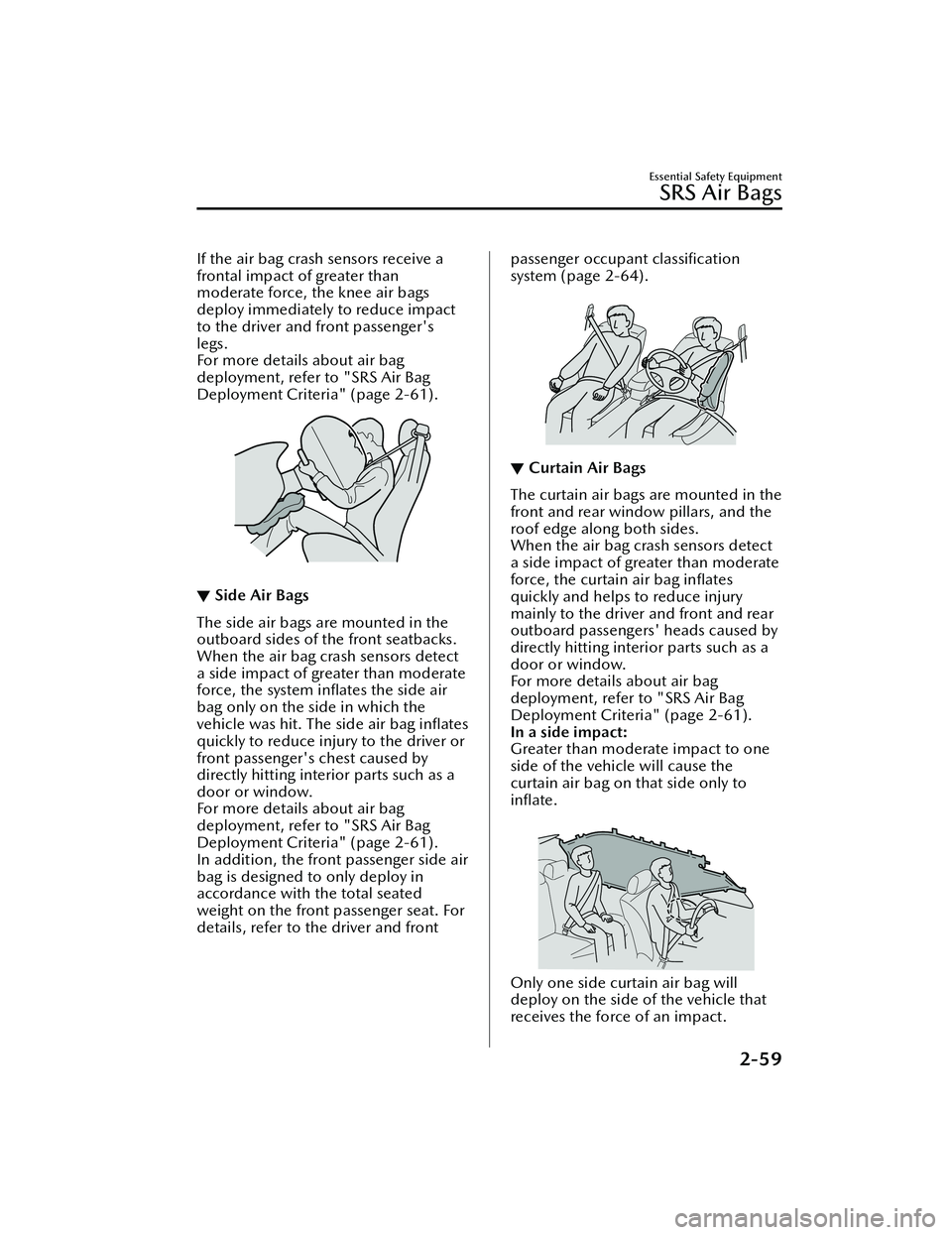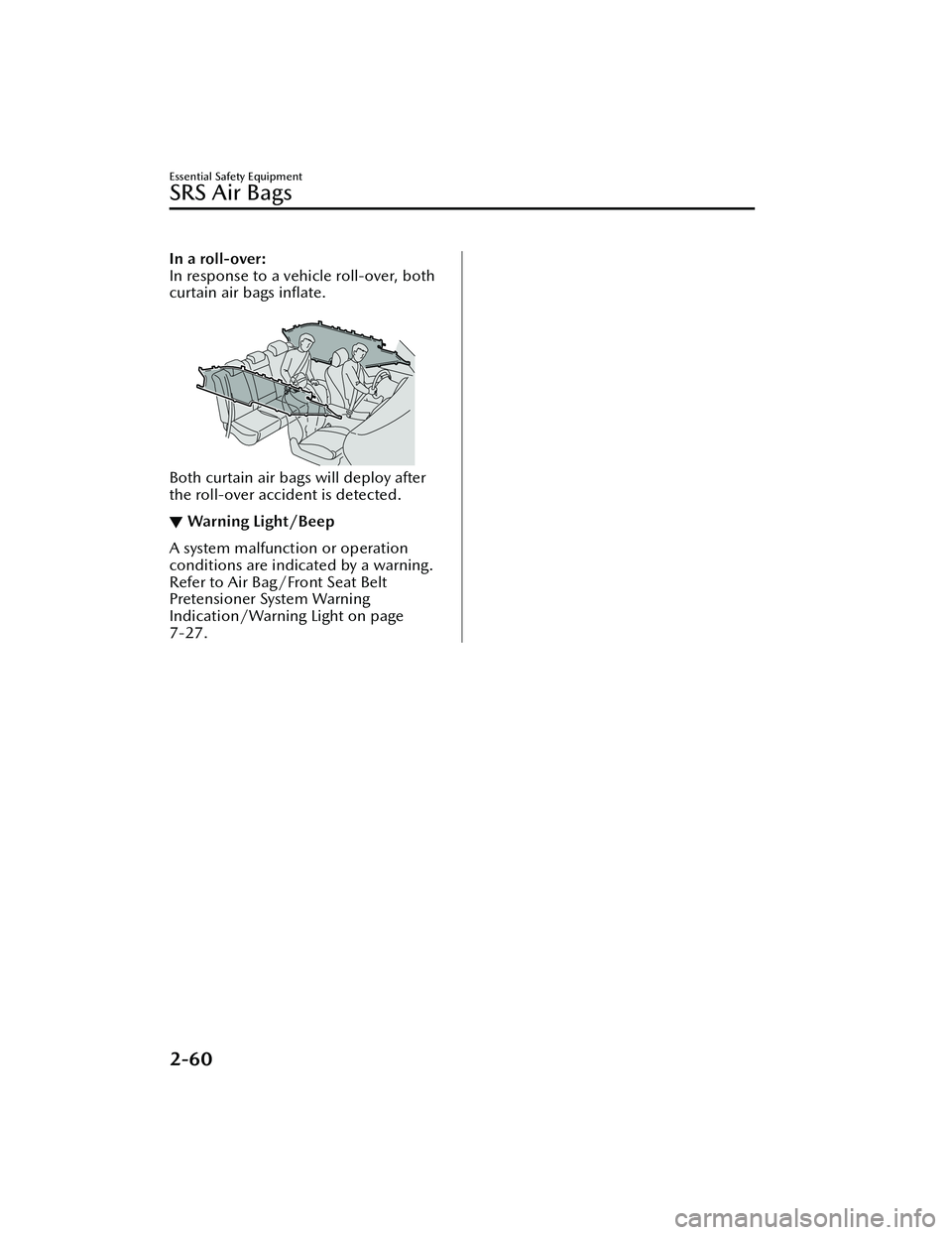MAZDA MODEL MX-30 EV 2022 Manual PDF
Manufacturer: MAZDA, Model Year: 2022, Model line: MODEL MX-30 EV, Model: MAZDA MODEL MX-30 EV 2022Pages: 547, PDF Size: 79.35 MB
Page 71 of 547

Sit in the center of the seat and wear
seat belts properly:
Sitting too close to the side air bag
modules or placing hands on them, or
sleeping up against the door or
hanging out the windows is extremely
dangerous. The side and curtain air
bags inflate with great force and speed
directly expanding along the door on
the side the car is hit. Serious injury
could occur if someone is sitting too
close to the door or leaning against a
window, or if rear seat occupants grab
the sides of the front seatbacks. Give
the side and curtain air bags room to
work by sitting in the center of the seat
while the vehicle is moving with seat
belts worn properly.
Do not attach objects on or around
the area where air bags deploy:
Attaching objects to the air bags or
placing something in the area where
the air bags deploy is dangerous. In an
accident, an object could interfere with
air bag in flation and injure the
occupants. Furthermore, the bag could
be damaged causing gases to release.
Always keep the deployment area of
the air bag modules free of any
obstructions.
For example, you should not do any of
the following as it may interfere with
air bag deployment.
Do not put a covering on or lean
anything against areas such as the
dashboard and lower portion of the
instrument panel that blocks the
passenger front air bag and knee air
bags.
Do not use seat covers on the front
seats and rear seats equipped with
in-seat side air bags.
Do not hang any backpacks, bags or
pouches that cover the sides of the
seats that block the side air bags.Do not place any objects on the
assist grips. Only hang clothes
directly on the coat hooks.
Do not touch the components of the
supplemental restraint system after
the air bags have in flated:
Touching the components of the
supplemental restraint system after the
air bags have in flated is dangerous.
Immediately after inflation, they are
very hot. You could get burned.
Never install any front-end equipment
to your vehicle:
Installation of front-end equipment,
such as frontal protection bar
(kangaroo bar, bull bar, push bar, or
other similar devices), snowplow, or
winches, is dangerous. The air bag
crash sensor system could be a ffected.
This could cause air bags to inflate
unexpectedly, or it could prevent the
air bags from inflating during an
accident. Front occupants could be
seriously injured.
Do not modify the suspension:
Modifying the vehicle suspension is
dangerous. If the vehicle's height or
the suspension is modi fied, the vehicle
will be unable to accurately detect a
collision or roll-over accident resulting
in incorrect or unexpected air bag
deployment and the possibility of
serious injuries.
To prevent false detection by the air
bag sensor system, heed the
following:
Do not use tires or wheels other than
those
specified for your Mazda:
Essential Safety Equipment
SRS Air Bags
2-54
MX
-30_8JD4-EA -21G_Edition2_new 2021-5-18 14:38:07
Page 72 of 547

Use of any tire or wheel other than
those specified for your Mazda (page
9-5) is dangerous. Use of such
wheels will prevent the vehicle's
accident detections system from
accurately detecting a collision or
roll-over accident resulting in
incorrect or unexpected air bag
deployment and the possibility of
serious injuries.
Do not overload your vehicle:
Overloading your vehicle is
dangerous as it could prevent the air
bag crash sensor system from
accurately detecting a collision or
roll-over accident resulting in
incorrect or unexpected air bag
deployment and the possibility of
serious injuries. The gross axle
weight rating (GAWR) and the gross
vehicle weight rating (GVWR) for
your vehicle are on the Motor
Vehicle Safety Standard Label on the
rear door on the driver's side. Do
not exceed these ratings.
Do not drive the vehicle o ff-road:
Driving your Mazda o ff-road is
dangerous because the vehicle has
not been designed to do so. Driving
the vehicle o ff-road could prevent
the air bag crash sensor system from
accurately detecting a collision or
roll-over accident resulting in
incorrect or unexpected air bag
deployment and the possibility of
serious injuries.
Do not modify a front door or leave
any damage unrepaired. Always have
an Authorized Mazda Dealer inspect a
damaged front door:Modifying a front door or leaving any
damage unrepaired is dangerous. Each
front door has a side crash sensor as a
component of the supplemental
restraint system. If holes are drilled in a
front door, a door speaker is left
removed, or a damaged door is left
unrepaired, the sensor could be
adversely a ffected causing it to not
detect the pressure of an impact
correctly during a si de collision. If a
sensor does not detect a side impact
correctly, the side and curtain air bags
and the front seat belt pretensioner
may not operate normally which could
result in serious injury to occupants.
Do not modify the supplemental
restraint system:
Modifying the components or wiring of
the supplemental restraint system is
dangerous. You could accidentally
activate it or make it inoperable. Do
not make any modi fications to the
supplemental restraint system. This
includes installing trim, badges, or
anything else over the air bag modules.
It also includes installing extra
electrical equipment on or near system
components or wiring. An Authorized
Mazda Dealer can provide the special
care needed in the removal and
installation of front seats. It is
important to protect the air bag wiring
and connections to assure that the
bags do not accidentally deploy, and
that the front passenger occupant
classi fication system and the seats
retain an undamaged air bag
connection.
Essential Safety Equipment
SRS Air Bags
2-55
MX -30_8JD4-EA -21G_Edition2_new 2021-5-18 14:38:07
Page 73 of 547

Do not place luggage or other objects
under the front seats:
Placing luggage or other objects under
the front seats is dangerous. The
components essential to the
supplemental restraint system could be
damaged, and in the event of a side
collision, the appropriate air bags may
not deploy, which could result in death
or serious injury. To prevent damage to
the components essential to the
supplemental restraint system, do not
place luggage or other objects under
the front seats.
Do not operate a vehicle with
damaged air bag/seat belt
pretensioner system components:
Expended or damaged air bag/seat
belt pretensioner system components
must be replaced after any collision
which caused them to deploy or
damage them. Only a trained
Authorized Mazda Dealer can fully
evaluate these systems to see that they
will work in any subsequent accident.
Driving with an expended or damaged
air bag or pretensioner unit will not
aff ord you the necessary protection in
the event of any subsequent accident
which could result in serious injury or
death.
Do not remove interior air bag parts:
Removing any components such as the
front seats, front dashboard, the
steering wheel or parts on the front
and rear window pillars and along the
roof edge, containing air bag parts or
sensors is dangerous. These parts
contain essential air bag components.
The air bag could accidentally activate
and cause serious injuries. Always have
an Authorized Mazda Dealer remove
these parts.Properly dispose of the air bag
system:
Improper disposal of an air bag or a
vehicle with live air bags in it can be
extremely dangerous. Unless all safety
procedures are followed, injury could
result. Have an Authorized Mazda
Dealer safely dispose of the air bag
system or scrap an air bag equipped
vehicle.
NOTE
If it becomes necessary to have the
components or wiring system for the
supplementary restraint system modi fied to accommodate a person
with certain medical conditions in
accordance with a certi fied
physician, contact an Authorized
Mazda Dealer, refer to “Customer
Assistance (U.S.A.)” (page 8-2).
When an air bag deploys, a loud in flation noise can be heard and
some smoke will be released.
Neither is likely to cause injury,
however, the texture of the air bags
may cause light skin injuries on body
parts not covered with clothing
through friction.
Should you sell your Mazda, we urge
you to tell the new owner of its air
bag systems and that familiarization
with all instructions about them,
from the Owner's Manual, is
important.
This highly-visible label is displayed
which warns against the use of a
rear-facing child-restraint system on
the front passenger seat.
Essential Safety Equipment
SRS Air Bags
2-56
MX -30_8JD4-EA -21G_Edition2_new 2021-5-18 14:38:07
Page 74 of 547

Supplemental Restraint System Components
▼Supplemental Restraint System Components
1. Side and curtain in
flators and air bags
2. Side crash sensors
3. Roll-over sensor, crash sensors, and diagnostic module (SAS unit)
4. Driver/Front passenger in flators and air bags
5. Air bag/front seat belt pretensioner system warning indication/warning light (page 7-27)
6. Driver/Front passenger knee in flators and air bags
7. Front passenger air bag deactivation indicator light (page 2-64)
8. Front air bag sensors
9. Seat belt pretensioners (page 2-31)
10.Front passenger seat we ight sensors (page 2-64)
11.Front passenger seat weight sensor control module
12.Driver and front passenger seat belt buckle switches (page 2-68)
13.Driver seat slide position sensor (page 2-64)
Essential Safety Equipment
SRS Air Bags
2-57
MX -30_8JD4-EA -21G_Edition2_new 2021-5-18 14:38:07
Page 75 of 547

How the SRS Air BagsWork
▼How the SRS Air Bags Work
Your Mazda is equipped with the
following types of SRS air bags. SRS air
bags are designed to work together
with the seat belts to help to reduce
injuries during an accident.
The SRS air bags are designed to
provide further protection for
passengers in addition to the seat belt
functions. Be sure to wear seat belts
properly.
▼Front Seat Belt Pretensioners
The front seat belt pretensioners are
designed to deploy in moderate or
severe frontal, near frontal collisions.
In addition, the pretensioners operate
when a side collision or a roll-over
accident is detected. The pretensioners
operate
differently depending on what
types of air bags are equipped. For
more details about seat belt
pretensioner operation, refer to the
SRS Air Bag Deployment Criteria (page
2-61).
▼ Driver Air Bag
The driver's air bag is mounted in the
steering wheel.
When air bag crash sensors detect a
frontal impact of greater than
moderate force, the driver's air bag
in
flates quickly helping to reduce injury
mainly to the driver's head or chest
caused by directly hitting the steering
wheel.
For more details about air bag
deployment, refer to "SRS Air Bag
Deployment Criteria" (page 2-61).
The driver's dual-stage air bag controls
air bag in flation in two energy stages.
During an impact of moderate severity,
the driver's air bag deploys with lesser
energy, whereas during more severe
impacts, it deploys with more energy.
▼ Front Passenger Air Bag
The front passenger air bag is mounted
in the front passenger dashboard.
The
inflation mechanism for the front
passenger air bag is the same as the
driver's air bag.
For more details about air bag
deployment, refer to "SRS Air Bag
Deployment Criteria" (page 2-61).
In addition, the front passenger air bag
is designed to only deploy in
accordance with the total seated
weight on the front passenger seat. For
details, refer to the driver and front
passenger occupant classi fication
system (page 2-64).
▼ Driver and Front Passenger Knee
Air Bags
The knee air bags are equipped under
the instrument panel.
Essential Safety Equipment
SRS Air Bags
2-58
MX
-30_8JD4-EA -21G_Edition2_new 2021-5-18 14:38:07
Page 76 of 547

If the air bag crash sensors receive a
frontal impact of greater than
moderate force, the knee air bags
deploy immediately to reduce impact
to the driver and front passenger's
legs.
For more details about air bag
deployment, refer to "SRS Air Bag
Deployment Criteria" (page 2-61).
▼Side Air Bags
The side air bags are mounted in the
outboard sides of the front seatbacks.
When the air bag crash sensors detect
a side impact of greater than moderate
force, the system
inflates the side air
bag only on the side in which the
vehicle was hit. The side air bag inflates
quickly to reduce injury to the driver or
front passenger's chest caused by
directly hitting interior parts such as a
door or window.
For more details about air bag
deployment, refer to "SRS Air Bag
Deployment Criteria" (page 2-61).
In addition, the front passenger side air
bag is designed to only deploy in
accordance with the total seated
weight on the front passenger seat. For
details, refer to the driver and front
passenger occupant classi fication
system (page 2-64).
▼ Curtain Air Bags
The curtain air bags are mounted in the
front and rear window pillars, and the
roof edge along both sides.
When the air bag crash sensors detect
a side impact of greater than moderate
force, the curtain air bag in
flates
quickly and helps to reduce injury
mainly to the driver and front and rear
outboard passengers' heads caused by
directly hitting interior parts such as a
door or window.
For more details about air bag
deployment, refer to "SRS Air Bag
Deployment Criteria" (page 2-61).
In a side impact:
Greater than moderate impact to one
side of the vehicle will cause the
curtain air bag on that side only to
in flate.
Only one side curtain air bag will
deploy on the side of the vehicle that
receives the force of an impact.
Essential Safety Equipment
SRS Air Bags
2-59
MX -30_8JD4-EA -21G_Edition2_new 2021-5-18 14:38:07
Page 77 of 547

In a roll-over:
In response to a vehicle roll-over, both
curtain air bags inflate.
Both curtain air bags will deploy after
the roll-over accident is detected.
▼ Warning Light/Beep
A system malfunction or operation
conditions are indicated by a warning.
Refer to Air Bag/Front Seat Belt
Pretensioner System Warning
Indication/Warning Light on page
7-27.
Essential Safety Equipment
SRS Air Bags
2-60
MX
-30_8JD4-EA -21G_Edition2_new 2021-5-18 14:38:07
Page 78 of 547

SRS Air Bag Deployment Criteria
▼SRS Air Bag Deployment Criteria
This chart indicates the applicable SRS eq
uipment that will deploy depending on the
type of collision.
(The illustrations are the representative cases of collisions.)
SRS equip-
ment Types of collision
A severe frontal/near frontal collision A severe side col-
lision A roll-over/near
roll-over
*2A rear collision
Essential Safety Equipment
SRS Air Bags
2-61
MX -30_8JD4-EA -21G_Edition2_new 2021-5-18 14:38:07
Page 79 of 547

SRS equip-ment Types of collision
A severe frontal/near frontal collision A severe side col-
lision A roll-over/near
roll-over
*2A rear collision
Front seat
belt preten- sioner X
*1X*1X*1
No air bag and
front seat belt
pretensioner will
be activated in a
rear collision.
Driver air
bag X
――
Front pas- senger air bag X
*1――
Knee air bag X
*1――
Side air bag ―X
*1 (impact side
only) ―
Curtain air bag ―
X (impact side
only) X (both sides)
X
: The SRS air bag equipment deploys in a collision.
― :The SRS air bag equipment does not deploy in a collision.
*1 The front passenger front and side air bags, seat belt pretensioner and knee air bag are designed to
deploy depending on the condition of the total seated weight on the front passenger seat.
*2 In a roll-over accident, the seat belt pretensioners and the curtain air bags deploy.
NOTE
In a frontal o ffset collision, the equipped air bags and pretensioners may all deploy
depending on the direction, angle, and rate of impact.
Essential Safety Equipment
SRS Air Bags
2-62
MX -30_8JD4-EA -21G_Edition2_new 2021-5-18 14:38:07
Page 80 of 547

Limitations to SRS Air Bag
▼Limitations to SRS Air Bag
In severe collisions such as those
described previously in "SRS Air Bag
Deployment Criteria", the applicable
SRS air bag equipment will deploy.
However, in some accidents, the
equipment may not deploy depending
on the type of collision and its severity.
Limitations to front/near front
collision detection:
The following illustrations are
examples of front/near front collisions
that may not be detected as severe
enough to deploy the SRS air bag
equipment.
Impacts involving trees or poles
Frontal
offset impact to the vehicle
Rear-ending or running under a
truck's tail gate
Limitations to side collision detection:
The following illustrations are
examples of side collisions that may
Essential Safety Equipment
SRS Air Bags
2-63
MX
-30_8JD4-EA -21G_Edition2_new 2021-5-18 14:38:07